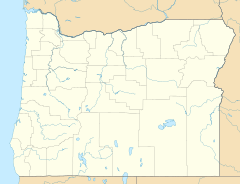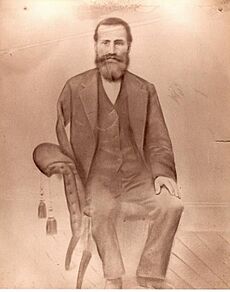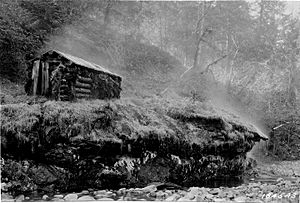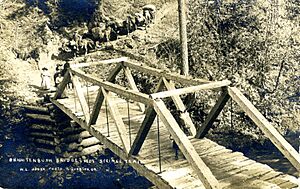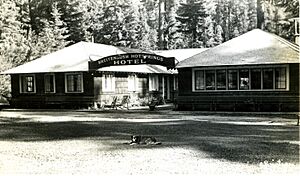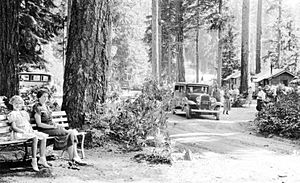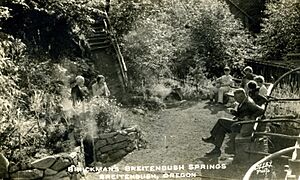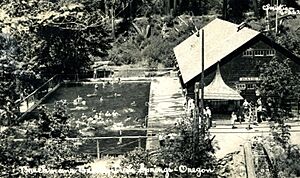Breitenbush, Oregon facts for kids
Quick facts for kids
Breitenbush
|
|
|---|---|
| Country | United States |
| State | Oregon |
| County | Marion |
| Elevation | 2,238 ft (682 m) |
| Time zone | UTC-8 (Pacific (PST)) |
| • Summer (DST) | UTC-7 (PDT) |
| ZIP code |
97342
|
| Area code(s) | 503 and 971 |
| GNIS feature ID | 1156681 |
Breitenbush is a small, unique community in Marion County, Oregon, United States. It's not a city, but an unincorporated community located about 10 miles northeast of Detroit, Oregon. It's also 10 miles northwest of the tall Mt. Jefferson. This special place is surrounded by the beautiful Willamette National Forest.
What makes Breitenbush famous are its amazing hot springs. These natural warm waters are found both nearby and right on the property. People believe the area was first settled in 1888. Since then, the hot springs have been developed and used in many different ways. For a while, when it was a popular resort, Breitenbush even had its own post office from 1928 to 1953.
Today, Breitenbush is home to the Breitenbush Hot Springs Retreat & Conference Center. This center is special because it's a worker-owned co-op. This means the people who work there also own and run the business together. Sometimes, the community also includes nearby summer vacation homes. These cabins are on land owned by the United States Forest Service. Their owners use them for holidays, but they aren't for living in all year.
About 70 people live in Breitenbush all year round. They work in special jobs at the retreat center. More staff might come for certain seasons, but they don't have permanent homes or jobs there. Since 2006, the community has its own fire department. It helps protect the retreat center, the vacation homes, and the wider Breitenbush Canyon area.
Contents
Exploring Breitenbush's Past
How Breitenbush Got Its Name
The name Breitenbush was given to a lake, a river, and the area by John Minto. He was an Oregon State politician. In 1874, Minto led a group looking for a path through Oregon's Central Cascade Mountains. During their trip, Minto's group met a hunter living in the wild Upper North Santiam canyon. This hunter was special because he only had one arm. Minto later named the area after him, calling it "John Breitenbush."
When Minto's maps were published in the 1880s, local people knew the hunter as Lewis Breitenbucher. They noticed that the name Minto used was not quite right. Lewis Breitenbucher had moved to the Upper North Santiam Canyon after his wife passed away in 1867. People wondered how he could survive in the wilderness with only one arm. Breitenbucher said he put a bat's eye under his tongue. He claimed this gave him amazing night vision and made him a great hunter. Because of this story, locals first called the hot springs and river "Bateye Springs" and "Bateye Creek." But by the late 1800s, the name from Minto's map became the common one.
Even though the area is named after him, Breitenbucher was not the first white person to visit the springs. As early as the 1830s, pioneers and fur trappers knew about the springs. They used the hot water to cook meat.
The Mansfield Family's Homestead
Claude Mansfield was the first person to officially settle the land around Breitenbush Hot Springs. He was from Albany, Oregon. It's thought he started living there as early as 1888. In 1889, Mansfield's first cabin burned down. But even so, news was spreading that Mansfield had claimed the land. He was making improvements to use it for business and farming. By 1901, trails, roads, and bridges were built. A horse pack train started running from Detroit. This made it easier for more visitors to reach the springs.
In May 1903, Mansfield faced a problem. The government said he couldn't claim the springs through the homestead act. This was because the area had become part of the Cascade Forest Reserve in 1893. A forest superintendent challenged Mansfield's claim in 1901. A local land office first sided with Mansfield. But on appeal, a federal official changed the decision. Several people had said that when they visited the springs, the land seemed empty. They saw no major improvements made by Mansfield.
In October 1903, the Secretary of the Interior heard Mansfield's appeal. This time, the decision was in his favor. President Theodore Roosevelt then gave Mansfield the permanent right to the land. Mansfield kept improving the hot springs. He helped it become known as a popular resort.
In 1905, Claude and his wife Harriet, also known as "Hattie," got divorced. Hattie and their son, Lorenzo, received one-third of the hot springs property. Claude died in 1906. The rest of his property went to his uncle, Dr. J.L. Hill. Dr. Hill owned part of the property with the Mansfields for many years. During this time, the springs became more popular for their believed health benefits. A famous accordion player named Count Guido Diero even spent several summers there writing music.
One of Mansfield's original cabins stayed on the Breitenbush property until 2010. It finally fell apart then.
Skiff's Camp: Another Hot Springs Spot
Around the same time as the Mansfield era, Dr. Mark Skiff from Salem, Oregon, became interested in another set of hot springs. These were located downriver from Mansfield's property. These smaller springs had been missed in earlier surveys. So, they became part of the Forest Service's land. In the early 1900s, Skiff built cabins at these "Lower Springs." He started to develop what would be called "Skiff's Camp." This new attraction opened in 1913. It competed with the resort at the Upper Spring for many years.
The Bruckman Family's Era
Both the Upper and Lower Springs became more popular in the 1900s. A company from Portland, Oregon, called the Breitenbush Hot Springs Company, was started in 1924. This company bought the combined Hill and Mansfield parts of the property. They hoped to make big improvements to the property. They wanted to turn it into a top resort by selling shares to investors. But they couldn't make enough progress. So, in 1925, they offered a 30-year lease-to-buy option to Merele Bruckman.
Merele was the son of a successful inventor, Frederick Bruckman. Frederick had been a childhood friend of Hattie Ross (Mansfield). In 1912, Fred invented a machine that made ice cream cones. In 1928, the patent for this machine was sold to Nabisco. This gave the Bruckman family a lot of money to invest in their Breitenbush project.
The Bruckman family, including Merele's parents, wife, and later, daughters, managed the property. They ran it as the Breitenbush Mineral Springs Company. This was during its most popular time as a health resort. They made many major improvements to the facilities. By 1936, the Bruckmans had finished building a large hotel. This building is now the historic Breitenbush lodge. They also built a big bathhouse, a swimming pool, a store, a gas station, a dance hall, and many new guest cabins. In 1927, a water turbine was installed. This allowed the resort to create its own electricity from the Breitenbush River. In 1938, Merele became the postmaster of the Breitenbush post office.
Hattie Ross (Mansfield) became a well-known artist and doll-maker while living in Portland. She married Frederick Bruckman in 1941. This brought her connection to the springs full circle.
The resort was open only during certain seasons because winter weather was very difficult. The heating system that uses geothermal energy, which is used there now, had not been installed yet. A very harsh winter in 1949 caused several buildings to collapse under eight feet of snow. After that, there was a fire. Merele Bruckman bought the resort from the old Breitenbush Hot Springs Company. But by the mid-1950s, he wanted to sell the property. Merele's daughter later said that harsh winters and more government rules made her father less excited about running the resort.


